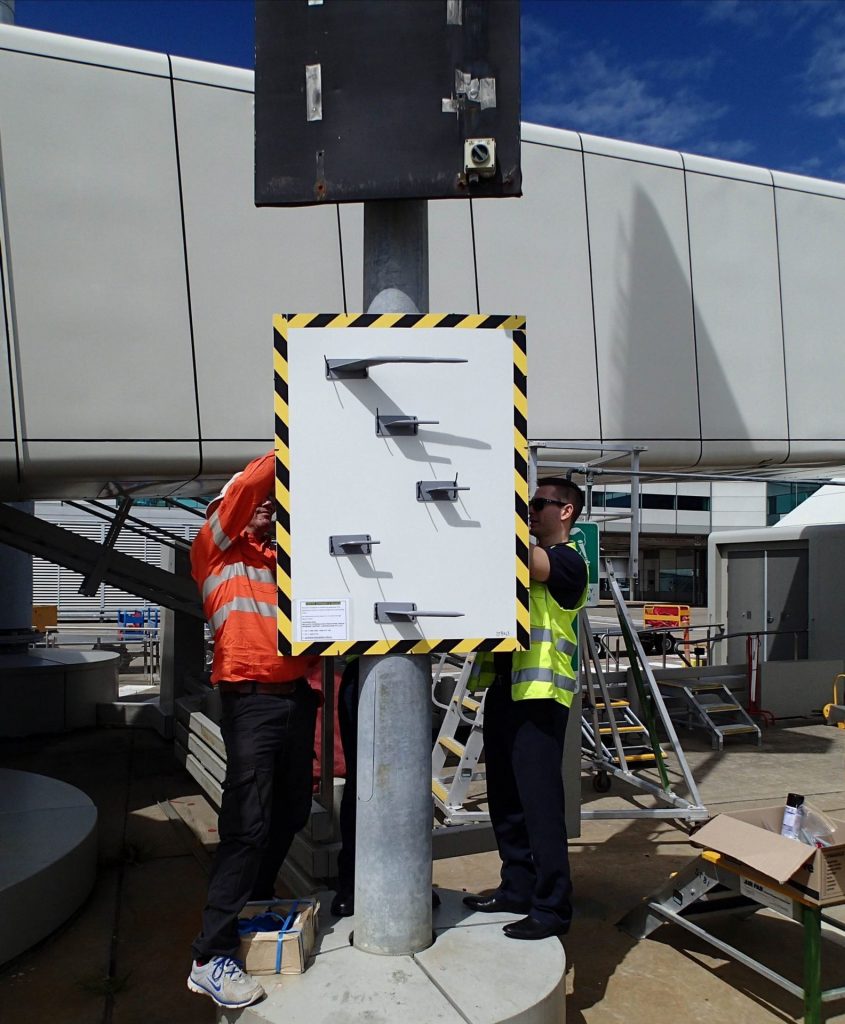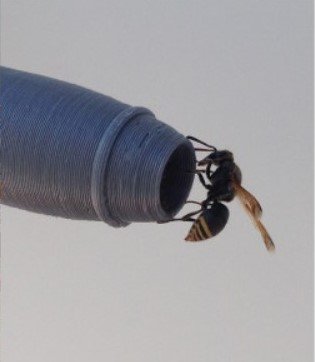Birds and other vertebrates are obvious hazards to aviation at airports. Yet, the threat of invertebrates, like keyhole wasps, is less understood. Brisbane Airport Corporation engaged Ecosure following the discovery of an exotic mud wasp nesting in the pitot tube of an aircraft. Our Managing Director Phil Shaw and former Principal Ecologist Alan House (now with collaborative partner Eco Logical Australia) wrote a scientific paper on a 39 month study on the mud-nesting keyhole wasp (Pachodynerus nasidens) at Brisbane Airport. The paper is due for release in PLOS One this week.
Discovery of the problem?
In 2013, an Airbus A330 prepared to take off from Brisbane Airport, however the pilot turned back after recording discrepancies with the airspeed readings. Once in the air, the airspeed discrepancies persisted, so the pilots issued a distress call to the tower, turned the plane around, and completed a fully loaded, yet safe landing. On inspection of the aircraft, the remains of what looked to be a wasp were found in one of the plane’s pitot tubes.
The pitot tube measures airspeed, and blockages cause faulty measurements, which can lead to the pilot making unnecessary adjustments to the aircraft which can lead to catastrophic outcomes. While considered a mud-nester, the keyhole wasp views aircraft pitot tubes (like keyholes) as a more efficient nesting opportunity and therefore blocks the tube.
(Keyhole wasp inspecting a pitot tube; covered pitot tube on front of an aircraft)
The Experiment
Panels of 3-D-printed, experimental replica pitot tubes of varying sizes (see below) were mounted at four locations at the airport. Monitoring revealed the keyhole wasps preferred tubes with 5-7 3 mm opening with peak nesting occurring between 24 and 31°C. The study also revealed the majority of nests were constructed in one area of the airport, and then focused on covering the tubes to see if this reduced nesting.

(Ecosure’s Bob Johnston installing the pitot tube panel with Jackson Ring from Brisbane Airport Corporation)
Risk was greatly reduced when 33% to 75% of tubes were covered on arrival of the aircraft at the airport. This is significant when the cost of wasp management at the airport is set against the costs of an aircraft incident. The paper also looked at eradicating the keyhole wasp and its spread to areas in Australia with a suitable climate and considers the significant risk the species presents to aviation.
The Solution
Unfortunately a simple transition to more slender pitot tubes is not as easy as it sounds. Pitot tubes are expensive and at a cost greater than $1,000 each, would be an immense expense to cover an entire fleet. Elimination of the wasps would be ideal, however there are no certainties that they would not return again in the future. Alternatively, fake nesting sites and covering pitot tubes when aircraft land are more cost effective and easier to implement solutions. The mandatory practice of covering pitot tubes is not widespread, yet if implemented in tropical and sub-tropical regions would significantly reduce the risk wasps pose. The findings from this research will assist airlines and airport managers to conduct risk assessments of their operations and respond respectively, to ensure the safety of all passengers. Improved practices at Brisbane Airport seem to have already made a difference.
“I’ve worked all over the world on the birdstrike risk, but this is the first time I’ve been involved with insects as an aviation threat. This ground-breaking research is really important for aviation safety” said Phil Shaw.
“There are simple ways of reducing the risk, and these appear to be working. The collaborative efforts of the Airport, airlines, aviation authorities and science and have resulted in a good outcome for travellers”, said Alan House. At present it is only a problem in Brisbane, but this species is an accomplished world-traveller and could turn up anywhere on the eastern seaboard in Australia or further afield”.
Now more than ever airports should be extra vigilant of the keyhole wasp. With plenty of aircraft parked up during the COVID-19 pandemic, the wasps are likely to have been nesting and increasing its population. But don’t let that deter you from planning your next getaway.
This research demonstrates how ecological science can inform management of risk to public health and industry. Ecosure are grateful to project partners Eco Logical Australia for their assistance on this valuable research, which contributes to our endeavours to provide innovative solutions that address human-wildlife conflict.
House A.P.N., Ring J.G., & Shaw P.P. (2020) Inventive nesting behaviour in the keyhole wasp Pachodynerus nasidensLatreille (Hymenoptera: Vespidae) in Australia, and the risk to aviation safety. PLoS ONE. doi: Check back here on 30 November 2020 to view the results.
House A.P.N., Ring J.G., Hill M.J. & Shaw P.P. (2020) Insects and aviation safety: the case of the keyhole wasp Pachodynerus nasidens (Hymenoptera: Vespidae) in Australia. Transportation Research: Interdisciplinary Perspectives. ScienceDirect. doi: 10.1016/j.trip.2020.100096.
#PhilShaw #AlanHouse #BNEAirport #Wasp #AviationHazards #Pachodynerusnasidens #MudNestingKeyholeWasp #PitotTubes #Aviation #EcoLogicalAustralia



